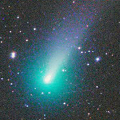
|
Now it is very bright as 5.8 mag (Dec. 5, Charles S. Morris). It will approach to Earth down to 0.2 a.u. in December, and it is expected to brighten up to 4 mag. In the Northern Hemisphere, it will be getting lower rapidly after this, but it stays observable until the end of 2021. In the Southern Hemisphere, it is observable in the low sky from mid December to mid January.
Date(TT) R.A. (2000) Decl. Delta r Elong. m1 Best Time(A, h)
Dec. 4 13 51.91 27 23.6 0.419 0.888 64 6.1 5:22 (264, 44)
Dec. 11 16 18.59 7 7.5 0.242 0.792 32 4.4 5:27 (268, 11)
|
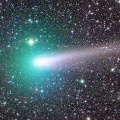
|
Now it is very bright as 8.9 mag (Dec. 4, Marco Goiato). It stays 9 mag until January, and it is observable in good condition.
Date(TT) R.A. (2000) Decl. Delta r Elong. m1 Best Time(A, h)
Dec. 4 8 49.94 27 6.8 0.429 1.275 123 8.8 3:59 ( 0, 82)
Dec. 11 8 57.91 27 22.6 0.437 1.305 129 8.9 3:40 ( 0, 82)
|
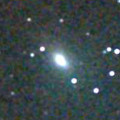
|
Now it is bright as 10.7 mag (Dec. 4, Marco Goiato). It stays bright as 9-10 mag until March. In the Southern Hemisphere, it is observable in excellent condition. It will be getting higher rapidly after this also in the Northren Hemisphere.
Date(TT) R.A. (2000) Decl. Delta r Elong. m1 Best Time(A, h)
Dec. 4 23 30.38 -36 21.0 1.176 1.485 86 10.1 18:38 ( 0, 19)
Dec. 11 23 40.73 -32 9.9 1.175 1.448 83 9.9 18:21 ( 0, 23)
|
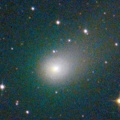
|
Now it is 9.9 mag (Dec. 4, Marco Goiato). It stays bright as 10 mag until spring for a long time. It stays observable in good condition for a long time. It locates somewhat low in the Southern Hemisphere,
Date(TT) R.A. (2000) Decl. Delta r Elong. m1 Best Time(A, h)
Dec. 4 7 38.20 37 9.2 2.766 3.570 139 10.0 2:48 (180, 88)
Dec. 11 7 32.94 36 15.2 2.700 3.565 146 9.9 2:16 (180, 89)
|
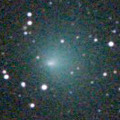
|
Now it is bright as 10.6 mag (Nov. 27, Marco Goiato). It is observable at 10 mag in good condition from October to December. In the Northern Hemisphere, it locates somewhat low at the high light.
Date(TT) R.A. (2000) Decl. Delta r Elong. m1 Best Time(A, h)
Dec. 4 22 39.28 -26 51.8 1.459 1.610 79 10.5 18:18 ( 8, 28)
Dec. 11 23 0.14 -25 8.5 1.545 1.651 78 10.8 18:19 ( 10, 29)
|
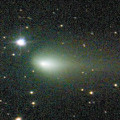
|
Now it is bright as 11.5 mag (Dec. 4, Osamu Miyazaki). It stays observable in good condition for a long time. But it will be fading gradually after this.
Date(TT) R.A. (2000) Decl. Delta r Elong. m1 Best Time(A, h)
Dec. 4 6 54.86 7 36.1 0.942 1.836 144 10.9 2:05 ( 0, 63)
Dec. 11 6 50.82 7 14.2 0.944 1.869 151 11.1 1:33 ( 0, 62)
|
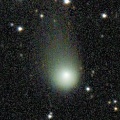
|
Now it is bright as 11.1 mag (Nov. 11, Osamu Miyazaki). It is expected to be observable at 5-6 mag for a long time from 2022 to 2023. In the Northern Hemisphere, it becomes extremely low temporarily in December, but it will be getting higher again after January. However, it is not observable at the high light from 2022 autumn to 2023 summer. In the Southern Hemisphere, it is not observable until February. But it will be observable in good condition at the high light.
Date(TT) R.A. (2000) Decl. Delta r Elong. m1 Best Time(A, h)
Dec. 4 17 35.43 15 58.1 5.350 4.644 40 11.3 18:18 (100, 14)
Dec. 11 17 40.81 15 11.0 5.308 4.582 38 11.2 18:19 (102, 9)
|
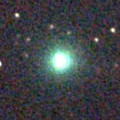
|
It brightened very rapidly, and brightened up to 8.9 mag (Sept. 11, Chris Wyatt). Now it is fading. But it is bright as 10.4 mag still now (Nov. 13, Chris Wyatt). In the Southern Hemisphere, it stays observable after this while the comet will be fading. But it stays locating low. It is not observable after this in the Northern Hemisphere.
Date(TT) R.A. (2000) Decl. Delta r Elong. m1 Best Time(A, h)
Dec. 4 14 29.83 -49 55.7 2.409 1.738 37 12.3 5:22 (324,-12)
Dec. 11 14 53.47 -51 4.4 2.471 1.810 38 12.8 5:27 (326,-12)
|
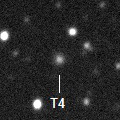
|
Now it is 13.3 mag (Nov. 5, Hiroshi Abe). It is expected to brighten up to 11.5 mag in 2022. In the Southern Hemisphere, it stas observable in good condition for a long time. It is getting observable also in the Northern Hemisphere.
Date(TT) R.A. (2000) Decl. Delta r Elong. m1 Best Time(A, h)
Dec. 4 11 43.83 -28 11.7 4.820 4.517 66 12.7 5:22 (338, 23)
Dec. 11 11 48.88 -28 35.4 4.713 4.498 71 12.6 5:27 (345, 25)
|
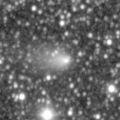
|
Major outburst occured on Oct. 17. Now it is very bright as 11.9 mag (Nov. 27, Toshihiko Ikemura, Hirohisa Sato). It stays observable in the evening sky for a while.
Date(TT) R.A. (2000) Decl. Delta r Elong. m1 Best Time(A, h)
Dec. 4 20 20.71 -18 0.5 2.213 1.775 51 12.7 18:18 ( 44, 24)
Dec. 11 20 39.98 -16 59.8 2.275 1.792 49 12.9 18:19 ( 47, 23)
|
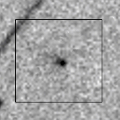
|
Now it is not observable. In the Southern Hemisphere, it will appear in the morning sky at 11 mag in late January, then it stays observable at 11 mag until June. In the Northern Hemisphere, it will appear in the morning sky in December, but it stays locating extremely low for a long time.
Date(TT) R.A. (2000) Decl. Delta r Elong. m1 Best Time(A, h)
Dec. 4 15 32.64 -15 58.5 2.782 1.864 17 13.2 5:22 (289, -1)
Dec. 11 15 51.32 -17 3.5 2.725 1.828 19 13.0 5:27 (292, 1)
|
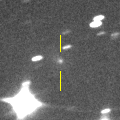
|
Now it is 14.7 mag (Nov. 24, Ken-ichi Kadota). Brightening rapidly. It is expected to be observable at 12-13 mag in good condition from December to February.
Date(TT) R.A. (2000) Decl. Delta r Elong. m1 Best Time(A, h)
Dec. 4 22 38.61 -9 36.2 0.743 1.191 85 13.4 18:18 ( 11, 45)
Dec. 11 22 56.71 -8 53.2 0.731 1.154 83 13.1 18:19 ( 15, 45)
|
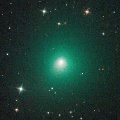
|
It brightened up to 9.5 mag in early summer (June 27, Marco Goiato). Now it is fading. It has already faded down to 13.4 mag (Oct. 25, Chris Wyatt). It is not observable already in the Northern Hemisphere. It will be unobservable soon also in the Southern Hemisphere.
Date(TT) R.A. (2000) Decl. Delta r Elong. m1 Best Time(A, h)
Dec. 4 18 38.78 -32 43.2 3.496 2.667 28 13.1 18:18 ( 51, -3)
Dec. 11 18 54.29 -33 0.9 3.580 2.717 24 13.3 18:19 ( 53, -5)
|

|
Major outburst occured on Sept. 25, and it brightened up to 10.0 mag (Oct. 1, Toshihiko Ikemura, Hirohisa Sato). Now it is fading. But it is bright as 10.8 mag still now (Dec. 2, Toshihiko Ikemura, Hirohisa Sato).
Date(TT) R.A. (2000) Decl. Delta r Elong. m1 Best Time(A, h)
Dec. 4 4 35.66 31 54.7 4.962 5.936 170 13.3 23:42 ( 0, 87)
Dec. 11 4 31.83 31 43.5 4.973 5.938 167 13.3 23:10 ( 0, 87)
|
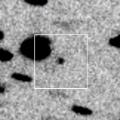
|
Now it is 15.5 mag (Nov. 14, Ken-ichi Kadota). It will brighten up to 12 mag from winter to spring. In the Northern Hemisphere, it is appearing in the morning sky. In the Southern Hemisphere, it is not observable until January.
Date(TT) R.A. (2000) Decl. Delta r Elong. m1 Best Time(A, h)
Dec. 4 14 21.57 -7 46.8 2.468 1.775 36 13.7 5:22 (293, 18)
Dec. 11 14 39.73 -9 30.7 2.401 1.744 38 13.5 5:27 (297, 19)
|

|
It brightened up to 12.3 mag from spring to summer (June 15, Marco Goiato). Now it is fading. It has already faded down to 14.1 mag (Nov. 23, Ken-ichi Kadota). In the Northern Hemisphere, it is appearing in the morning sky. It is not observable until January in the Southern Hemisphere.
Date(TT) R.A. (2000) Decl. Delta r Elong. m1 Best Time(A, h)
Dec. 4 14 22.48 0 50.6 4.663 3.970 40 14.0 5:22 (286, 23)
Dec. 11 14 24.68 1 33.4 4.603 4.004 47 14.0 5:27 (291, 29)
|
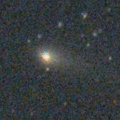
|
Now it is 13.1 mag (Nov. 27, Toshihiko Ikemura, Hirohisa Sato). It stays 13-14 mag unil December, and it is observable in excellent condition.
Date(TT) R.A. (2000) Decl. Delta r Elong. m1 Best Time(A, h)
Dec. 4 0 53.89 -1 44.6 0.985 1.704 119 14.2 20:01 ( 0, 53)
Dec. 11 1 3.74 -0 44.5 1.044 1.714 115 14.4 19:44 ( 0, 54)
|
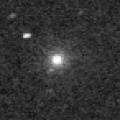
|
It was observed at 9-10 mag from late July to early August. Although it had been unobservable for a long time, it is appearing in the morning sky now.
Date(TT) R.A. (2000) Decl. Delta r Elong. m1 Best Time(A, h)
Dec. 4 15 11.15 -17 7.9 2.939 2.056 21 14.5 5:22 (293, 2)
Dec. 11 15 22.73 -18 31.7 2.993 2.149 25 14.7 5:27 (297, 5)
|

|
Now it is 16.1 mag (Nov. 28, G. Duszanowicz). It is expected to brighten up to 13 mag in 2022. In the Southern Hemisphere, it stays observable in good condition for a long time. In the Northern Hemisphere, it becomes observable temporarily in the extremely low sky in December. But it becomes unobservable again soon.
Date(TT) R.A. (2000) Decl. Delta r Elong. m1 Best Time(A, h)
Dec. 4 12 48.25 -43 35.1 4.171 3.650 52 14.7 5:22 (333, 4)
Dec. 11 12 49.30 -45 43.4 4.058 3.617 56 14.6 5:27 (339, 4)
|
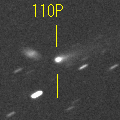
|
It brightened rapidly. Now it is 15.6 mag (Nov. 28, Toshihiko Ikemura, Hirohisa Sato). It is observable at 15 mag in excellent condition in winter.
Date(TT) R.A. (2000) Decl. Delta r Elong. m1 Best Time(A, h)
Dec. 4 8 41.22 17 58.4 1.785 2.473 123 15.2 3:51 ( 0, 73)
Dec. 11 8 41.22 17 20.9 1.721 2.478 130 15.2 3:23 ( 0, 72)
|

|
Now it is 15.8 mag (Oct. 4, Thomas Lehmann). Now it is not observable. It will appear in the morning sky at 15 mag in January. Then it will brighten up to 13 mag in 2022 summer.
Date(TT) R.A. (2000) Decl. Delta r Elong. m1 Best Time(A, h)
Dec. 4 15 58.05 -20 26.9 4.183 3.218 10 15.2 5:22 (289, -9)
Dec. 11 16 9.01 -21 6.5 4.150 3.207 14 15.2 5:27 (292, -5)
|

|
Now it is 16.1 mag (Nov. 22, Thomas Lehmann). It will brighten up to 12.5 mag in 2022 summer. In the Southern Hemisphere, it stays observable in excellent condition for a long time. In the Northern Hemisphere, it is not observable until August in 2022.
Date(TT) R.A. (2000) Decl. Delta r Elong. m1 Best Time(A, h)
Dec. 4 22 42.37 -71 12.1 4.299 4.054 69 15.2 18:18 ( 2,-16)
Dec. 11 22 32.25 -69 36.8 4.324 4.011 65 15.2 18:19 ( 6,-15)
|
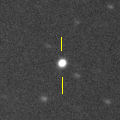
|
Now it is 14.1 mag (Nov. 28, Toshihiko Ikemura, Hirohisa Sato). It is expected to brighten up to 10 mag in 2023. In the Northern Hemisphere, it stays observable in good condition until 2023 autumn. In the Southern Hemipshere, it stays unobservable until 2023 summer.
Date(TT) R.A. (2000) Decl. Delta r Elong. m1 Best Time(A, h)
Dec. 4 12 59.91 36 55.6 5.828 5.718 78 15.4 5:22 (255, 56)
Dec. 11 13 2.37 37 49.8 5.674 5.663 84 15.3 5:27 (254, 62)
|
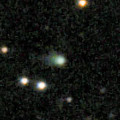
|
Now it is 15.3 mag (Oct. 29, Toshihiko Ikemura, Hirohisa Sato). It is expected to brighten up to 11 mag in 2023. In the Northern Hemisphere, it stays observable in good condition for a long time, although it became low temporarily in November. It is not observable in the Southern Hemisphere.
Date(TT) R.A. (2000) Decl. Delta r Elong. m1 Best Time(A, h)
Dec. 4 16 24.95 31 15.4 6.045 5.517 53 15.4 5:22 (242, 15)
Dec. 11 16 27.82 31 2.0 5.980 5.475 55 15.3 5:27 (246, 20)
|
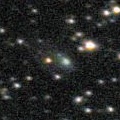
|
Now it is 14.9 mag (Nov. 28, Thomas Lehmann). It is expected to brighten up to 11 mag from spring to summer in 2022. In the Southen Hemisphere, it is not observable until February, but it stays observable in good condition for a long time after that. In the Northern Hemisphere, it is hardly observable after this.
Date(TT) R.A. (2000) Decl. Delta r Elong. m1 Best Time(A, h)
Dec. 4 18 54.34 -1 52.9 3.633 2.923 38 15.5 18:18 ( 73, 20)
Dec. 11 18 59.31 -3 19.7 3.640 2.861 32 15.4 18:19 ( 75, 14)
|

|
Now it is 15.9 mag (Oct. 8, Thomas Lehmann). It stays at 14-15 mag for a long time from 2021 to 2022. It is not observable from November to January.
Date(TT) R.A. (2000) Decl. Delta r Elong. m1 Best Time(A, h)
Dec. 4 16 47.58 -25 51.0 5.981 4.999 3 15.4 18:18 ( 71,-19)
Dec. 11 16 51.37 -26 39.1 5.980 5.001 5 15.4 5:27 (292,-16)
|

|
Now it is 15.2 mag (Nov. 29, Toshihiko Ikemura, Hirohisa Sato). It will be fading after this. In the Southern Hemisphere, it stays observable in good condition for a long time. It locates low in the Northern Hemisphere.
Date(TT) R.A. (2000) Decl. Delta r Elong. m1 Best Time(A, h)
Dec. 4 22 27.10 -19 46.1 4.884 4.805 79 15.6 18:18 ( 12, 34)
Dec. 11 22 29.47 -18 37.3 5.016 4.830 73 15.6 18:19 ( 20, 34)
|
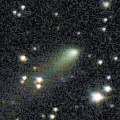
|
Now it is 15.1 mag (Nov. 10, Ken-ichi Kadota). It will be fading after this. In the Northern Hemisphere, it stays observable in good condition for a long time, although it became extremely low temporarily in November. In the Southern Hemisphere, it is not observable until late January.
Date(TT) R.A. (2000) Decl. Delta r Elong. m1 Best Time(A, h)
Dec. 4 16 11.22 17 13.2 3.087 2.417 40 15.6 5:22 (256, 10)
Dec. 11 16 12.29 17 36.8 3.067 2.442 43 15.7 5:27 (260, 17)
|
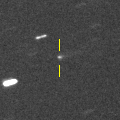
|
Now it is 15.4 mag (Dec. 3, Toshihiko Ikemura, Hirohisa Sato). It will brighten rapidly, and it will be observable at 13.5 mag in good condition from winter to spring.
Date(TT) R.A. (2000) Decl. Delta r Elong. m1 Best Time(A, h)
Dec. 4 9 57.67 16 55.0 2.219 2.665 106 15.9 5:07 ( 0, 72)
Dec. 11 10 2.16 16 40.5 2.109 2.641 112 15.7 4:44 ( 0, 72)
|
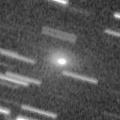
|
Now it is 15.7 mag (Nov. 28, Toshihiko Ikemura, Hirohisa Sato). It will be fading after this, and it will be fainter than 18 mag in February. It will be observable in excellent condition in the Northern Hemisphere. It locates somewhat low in the Southern Hemisphere.
Date(TT) R.A. (2000) Decl. Delta r Elong. m1 Best Time(A, h)
Dec. 4 7 25.25 36 1.7 0.978 1.856 141 15.7 2:35 (180, 89)
Dec. 11 7 22.11 37 21.4 0.975 1.887 148 15.8 2:05 (180, 88)
|

|
Now it is 15 mag (Oct. 31, Giuseppe Pappa). It was expected to brighten up to 13 mag from spring to summer. But actually, it is fainter than originally expected. It will be fading slowly after this. In the Southern Hemisphere, it stays observable in good condition for a long time. In the Northern Hemisphere, it is not observable until July in 2022.
Date(TT) R.A. (2000) Decl. Delta r Elong. m1 Best Time(A, h)
Dec. 4 22 30.66 -62 32.7 4.127 3.889 69 15.7 18:18 ( 5, -8)
Dec. 11 22 40.74 -60 29.3 4.202 3.913 66 15.7 18:19 ( 7, -6)
|

|
Now it is 15.2 mag (Nov. 13, ATLAS-MLO, Mauna Loa). It will be fading slowly after this. It will be unobservable in December.
Date(TT) R.A. (2000) Decl. Delta r Elong. m1 Best Time(A, h)
Dec. 4 20 22.75 -31 3.8 3.773 3.227 49 15.7 18:18 ( 36, 13)
Dec. 11 20 33.30 -30 27.1 3.859 3.243 45 15.8 18:19 ( 40, 11)
|
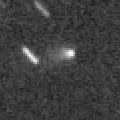
|
Now it is 17.6 mag (Nov. 5, Toshihiko Ikemura, Hirohisa Sato). It is expected to brighten up to 15.5 mag in winter. In the Northern Hemisphere, it stays observable in good condition for a long time. It is not observable at all in the Southern Hemisphere. It is fainter than this ephemeris recently.
Date(TT) R.A. (2000) Decl. Delta r Elong. m1 Best Time(A, h)
Dec. 4 16 6.64 63 55.0 2.908 3.011 86 15.8 5:22 (211, 32)
Dec. 11 16 12.52 65 3.9 2.852 2.997 88 15.7 5:27 (211, 35)
|
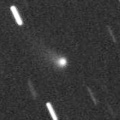
|
Now it is 15.5 mag (Dec. 4, Toshihiko Ikemura, Hirohisa Sato). In the Northern Hemisphere, it stays observable at 15-16 mag for a long time until early 2022. It is appearing in the morning sky also in the Southern Hemisphere.
Date(TT) R.A. (2000) Decl. Delta r Elong. m1 Best Time(A, h)
Dec. 4 13 19.20 17 22.6 3.501 3.182 63 15.8 5:22 (281, 45)
Dec. 11 13 19.74 16 29.3 3.423 3.205 69 15.8 5:27 (288, 51)
|
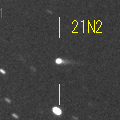
|
Brightened rapidly. Now it is 15.7 mag (Nov. 27, Toshihiko Ikemura, Hirohisa Sato). It is observable at 15.5-16 mag in good condition until winter.
Date(TT) R.A. (2000) Decl. Delta r Elong. m1 Best Time(A, h)
Dec. 4 2 3.63 12 21.1 2.979 3.799 141 15.8 21:10 ( 0, 67)
Dec. 11 2 2.75 11 56.6 3.051 3.800 133 15.9 20:42 ( 0, 67)
|
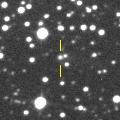
|
First return of a new periodic comet observed at 16 mag from 2003 to 2004. Now it is 16.0 mag (Nov. 27, Toshihiko Ikemura, Hirohisa Sato). It will brighten up to 16 mag in winter, and it will be observable in excellent condition.
Date(TT) R.A. (2000) Decl. Delta r Elong. m1 Best Time(A, h)
Dec. 4 6 33.81 1 12.5 3.087 3.938 145 15.9 1:44 ( 0, 56)
Dec. 11 6 30.26 1 34.6 3.046 3.938 151 15.9 1:13 ( 0, 57)
|
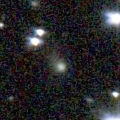
|
Now it is 16.0 mag (Nov. 5, Ken-ichi Kadota). It is expected to brighten up to 11 mag in 2023. In the Northern Hemisphere, it is observable only until November in 2022. In the Southern Hemisphere, it is not observable until February. But it will be observable in good condition at the high light.
Date(TT) R.A. (2000) Decl. Delta r Elong. m1 Best Time(A, h)
Dec. 4 17 57.48 21 6.3 6.289 5.665 47 16.0 18:18 (101, 21)
Dec. 11 18 2.15 20 23.0 6.268 5.617 45 16.0 18:19 (104, 16)
|
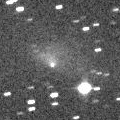
|
It brightened up to 10.1 mag in spring (Apr. 10, Marco Goiato). Now it is fading. It has already faded down to 16.0 mag (Dec. 2, Toshihiko Ikemura, Hirohisa Sato). It stays observable in good condition for a long time after this while the comet will fading.
Date(TT) R.A. (2000) Decl. Delta r Elong. m1 Best Time(A, h)
Dec. 4 4 6.49 5 31.0 1.736 2.688 161 16.1 23:12 ( 0, 61)
Dec. 11 3 59.78 5 47.9 1.802 2.729 155 16.3 22:38 ( 0, 61)
|
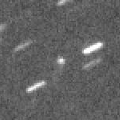
|
Now it is 16.8 mag (Nov. 28, Toshihiko Ikemura, Hirohisa Sato). It will brighten up to 16 mag in 2022. In the Northern Hemisphere, it stays observable in good condition for a long time. In the Southern Hemisphere, it is not observable until 2023.
Date(TT) R.A. (2000) Decl. Delta r Elong. m1 Best Time(A, h)
Dec. 4 10 14.22 76 26.9 3.476 3.968 113 16.2 5:22 (180, 49)
Dec. 11 10 25.75 79 19.2 3.435 3.949 114 16.1 5:08 (180, 46)
|
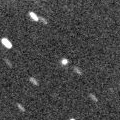
|
Now it is 16.9 mag (Dec. 1, Toshihiko Ikemura, Hirohisa Sato). It is expected to brighten up to 4.5 mag in 2022 April. However, it is not observable at the high light. In the Northern Hemisphere, it stays observable until early February when it brightens up to 14 mag. Then it will appear at 6 mag in mid May, and it stays observable in good condition after that while the comet will be fading. In the Southern Hemisphere, it stays observable until December when it brightens up to 16 mag. But after that, it is not observable until 2022 August.
Date(TT) R.A. (2000) Decl. Delta r Elong. m1 Best Time(A, h)
Dec. 4 21 57.34 7 17.8 2.621 2.682 82 16.4 18:18 ( 36, 58)
Dec. 11 22 0.18 6 3.6 2.635 2.583 76 16.2 18:19 ( 44, 53)
|
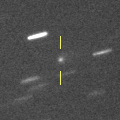
|
Now it is 16.2 mag (Dec. 2, Toshihiko Ikemura, Hirohisa Sato). It will brighten up to 15.5 mag, and will be observable in excellent condition in winter.
Date(TT) R.A. (2000) Decl. Delta r Elong. m1 Best Time(A, h)
Dec. 4 11 0.09 8 26.1 1.789 2.025 88 16.3 5:22 (335, 61)
Dec. 11 11 10.69 7 49.6 1.723 2.033 93 16.2 5:27 (347, 62)
|
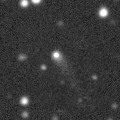
|
It stays observable at 16 mag from 2021 to 2022. Appearing in the morning sky in the Northern Hemisphere. In the Southern Hemisphere, it will appear in the morning sky in January.
Date(TT) R.A. (2000) Decl. Delta r Elong. m1 Best Time(A, h)
Dec. 4 15 19.09 6 51.9 5.500 4.730 35 16.3 5:22 (272, 15)
Dec. 11 15 25.36 7 31.1 5.448 4.736 40 16.3 5:27 (275, 21)
|
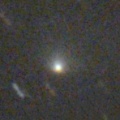
|
It brightened up to 14.5 mag in autumn (Oct. 1, Ken-ichi Kadota). Now it is fading. It has already faded down to 16.3 mag (Nov. 27, Toshihiko Ikemura, Hirohisa Sato). It will be fading rapidly after this. It will be fainter than 18 mag in February.
Date(TT) R.A. (2000) Decl. Delta r Elong. m1 Best Time(A, h)
Dec. 4 23 32.93 -14 13.7 2.045 2.365 96 16.5 18:40 ( 0, 41)
Dec. 11 23 40.84 -13 17.3 2.139 2.377 91 16.7 18:21 ( 0, 42)
|
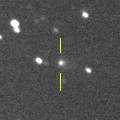
|
Now it is 15.8 mag (Nov. 27, Toshihiko Ikemura, Hirohisa Sato). It continues brightening even after the perihelion passage. It stays observable at 16-17 mag in good condition for a while.
Date(TT) R.A. (2000) Decl. Delta r Elong. m1 Best Time(A, h)
Dec. 4 4 45.88 -16 15.6 3.019 3.840 141 16.5 23:51 ( 0, 39)
Dec. 11 4 40.97 -15 52.8 3.047 3.858 140 16.6 23:19 ( 0, 39)
|
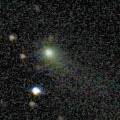
|
Now it is 17.3 mag (Nov. 27, Toshihiko Ikemura, Hirohisa Sato). It stays observable in good condition for a long time. But it will be fading after this.
Date(TT) R.A. (2000) Decl. Delta r Elong. m1 Best Time(A, h)
Dec. 4 23 20.03 5 24.2 1.884 2.288 101 16.6 18:27 ( 0, 61)
Dec. 11 23 27.77 6 12.6 1.980 2.304 96 16.7 18:19 ( 6, 61)
|
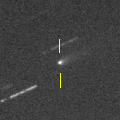
|
Now it is 16.7 mag (Dec. 3, Toshihiko Ikemura, Hirohisa Sato). It stays observable at 17 mag from autumn to winter.
Date(TT) R.A. (2000) Decl. Delta r Elong. m1 Best Time(A, h)
Dec. 4 11 52.50 2 50.2 1.865 1.864 74 16.7 5:22 (319, 50)
Dec. 11 12 3.88 1 2.2 1.817 1.885 78 16.7 5:27 (328, 51)
|
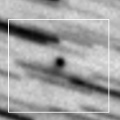
|
Now it is 17.1 mag (Nov. 27, Toshihiko Ikemura, Hirohisa Sato). It is expected to brighten up to 11 mag in 2022 summer. In the Northern Hemisphere, it stays observable in good condition until 2022 June when it brightens up to 11 mag. But it is not observable after the high light. In the Souther Hemisphere, it is not observable until 2022 October.
Date(TT) R.A. (2000) Decl. Delta r Elong. m1 Best Time(A, h)
Dec. 4 22 31.34 56 33.6 3.042 3.462 107 16.8 18:18 (166, 67)
Dec. 11 22 30.63 55 24.1 3.023 3.386 103 16.7 18:19 (155, 66)
|
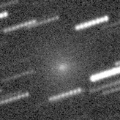
|
Now it is 15.6 mag (Nov. 17, Thomas Lehmann). It stays observable in good condition for a long time. It will be fading rapidly after this, and it will be fainter than 18 mag in January.
Date(TT) R.A. (2000) Decl. Delta r Elong. m1 Best Time(A, h)
Dec. 4 10 57.05 -6 0.1 1.445 1.662 84 16.7 5:22 (344, 48)
Dec. 11 11 4.66 -7 37.9 1.426 1.713 88 16.9 5:27 (353, 47)
|

|
Now it is 16.4 mag (Nov. 14, F. Kugel, M. Audejean, J. Nicolas, J.-G. Bosch). It brightened rapidly. It stays 17 mag for a long time from 2021 to 2022. In the Southern Hemisphere, it stays observable in good condition for a long time. In the Northern Hemisphere, it will be observable only in extremely low sky from autumn to winter.
Date(TT) R.A. (2000) Decl. Delta r Elong. m1 Best Time(A, h)
Dec. 4 8 56.58 -38 18.8 5.159 5.334 94 16.7 4:06 ( 0, 17)
Dec. 11 8 51.21 -39 53.9 5.093 5.336 98 16.7 3:33 ( 0, 15)
|
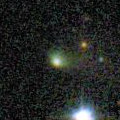
|
Now it is 16.9 mag (Nov. 27, Toshihiko Ikemura, Hirohisa Sato). It continued brightening even after the perihelion passage. But it will be fading after this, and it will be fainter than 18 mag in January.
Date(TT) R.A. (2000) Decl. Delta r Elong. m1 Best Time(A, h)
Dec. 4 0 56.36 -13 9.6 2.675 3.212 114 16.9 20:03 ( 0, 42)
Dec. 11 0 58.78 -12 28.2 2.799 3.252 108 17.1 19:38 ( 0, 43)
|
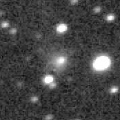
|
Now it is 16.7 mag (Dec. 1, Toshihiko Ikemura, Hirohisa Sato). Fading slowly. It is not observable until April in the Southern Hemisphere.
Date(TT) R.A. (2000) Decl. Delta r Elong. m1 Best Time(A, h)
Dec. 4 21 32.46 22 5.1 6.286 6.255 83 16.9 18:18 ( 66, 65)
Dec. 11 21 33.95 21 2.4 6.407 6.270 77 17.0 18:19 ( 71, 59)
|
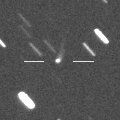
|
It was expected to brighten up to 14.5 mag from spring to summer. But actually, it is fainter than expected. Now it is 16.4 mag (Oct. 4, ATLAS-MLO, Mauna Loa). In the Southern Hemisphere, it stays observable for a long time. In the Northern Hemisphere, it is not observable after this.
Date(TT) R.A. (2000) Decl. Delta r Elong. m1 Best Time(A, h)
Dec. 4 12 1.36 -53 13.4 3.899 3.519 60 17.0 5:22 (344, -1)
Dec. 11 12 0.72 -53 37.7 3.875 3.564 64 17.0 5:27 (349, 0)
|

|
First return of a new periodic comet which brightened up to 17 mag in 2011. Now it is 17.6 mag (Dec. 3, Toshihiko Ikemura, Hirohisa Sato). It stays observable at 17 mag in good condition until spring.
Date(TT) R.A. (2000) Decl. Delta r Elong. m1 Best Time(A, h)
Dec. 4 12 27.84 1 30.8 1.668 1.555 66 17.0 5:22 (309, 44)
Dec. 11 12 46.02 -0 21.4 1.626 1.557 68 17.0 5:27 (315, 45)
|
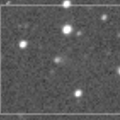
|
First return of a new periodic comet which brightened up to 17 mag in 2006. Now it is 17.2 mag (Nov. 23, ATLAS-HKO, Haleakala). It stays 17 mag from 2021 to 2022. In the Southern Hemisphere, it stays observable in good condition for a while. It locates extremely low in the Northern Hemisphere.
Date(TT) R.A. (2000) Decl. Delta r Elong. m1 Best Time(A, h)
Dec. 4 22 16.10 -45 54.7 3.313 3.118 70 17.0 18:18 ( 9, 8)
Dec. 11 22 24.73 -43 49.3 3.380 3.114 66 17.0 18:19 ( 13, 10)
|

|
Now it is 16.5 mag (Nov. 29, Toshihiko Ikemura, Hirohisa Sato). Fading slowly. In the Northern Hemisphere, it stays observable in good condition for a long time. In the Southern Hemisphere, it is not observable after this.
Date(TT) R.A. (2000) Decl. Delta r Elong. m1 Best Time(A, h)
Dec. 4 18 34.50 47 0.1 9.183 8.958 73 17.0 18:18 (126, 38)
Dec. 11 18 37.85 47 4.2 9.209 8.965 72 17.1 18:19 (127, 34)
|
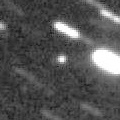
|
Now it is 16.3 mag (Dec. 2, Toshihiko Ikemura, Hirohisa Sato). In the Northern Hemisphere, it stays observable in good condition after this while the comet will be fading. In the Southern Hemisphere, it stays locating extremely low for a long time.
Date(TT) R.A. (2000) Decl. Delta r Elong. m1 Best Time(A, h)
Dec. 4 4 43.20 42 47.5 2.312 3.253 159 17.1 23:49 (180, 82)
Dec. 11 4 35.36 42 25.5 2.369 3.307 159 17.1 23:14 (180, 83)
|
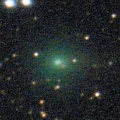
|
It brightened very rapidly up to 10.7 mag in July (July 20, Osamu Miyazaki). Now it is fading. It has already faded down to 17.6 mag (Dec. 2, Toshihiko Ikemura, Hirohisa Sato). It stays observable in the morning sky for a long time.
Date(TT) R.A. (2000) Decl. Delta r Elong. m1 Best Time(A, h)
Dec. 4 9 2.37 27 30.9 1.388 2.076 121 17.1 4:12 ( 0, 82)
Dec. 11 8 57.91 28 11.8 1.378 2.140 129 17.2 3:40 ( 0, 83)
|
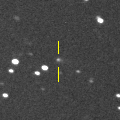
|
Now it is 16.7 mag (Nov. 27, Toshihiko Ikemura, Hirohisa Sato). It will brighten up to 14 mag in early 2023. It stays observable in good condition for a long time until spring.
Date(TT) R.A. (2000) Decl. Delta r Elong. m1 Best Time(A, h)
Dec. 4 4 37.38 2 25.2 4.197 5.136 160 17.2 23:43 ( 0, 57)
Dec. 11 4 33.85 2 30.9 4.168 5.092 157 17.2 23:12 ( 0, 58)
|
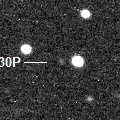
|
Now it is 18.5 mag (Nov. 28, Toshihiko Ikemura, Hirohisa Sato). It is expected to brighten up to 16.5-17 mag in winter. In its last apparition in 2015, it brightened up to 13 mag. But actually, it is fainter than this ephemeris recently.
Date(TT) R.A. (2000) Decl. Delta r Elong. m1 Best Time(A, h)
Dec. 4 22 32.12 -26 0.7 1.807 1.880 78 17.2 18:18 ( 10, 29)
Dec. 11 22 43.81 -24 29.2 1.840 1.844 74 17.2 18:19 ( 14, 29)
|

|
Now it is 17.2 mag (Nov. 28, Toshihiko Ikemura, Hirohisa Sato). It stays 17-18 mag for a long time from 2021 to 2022. It is observable in excellent condition in the Northern Hemisphere, It locates somewhat low in the Southern Hemisphere.
Date(TT) R.A. (2000) Decl. Delta r Elong. m1 Best Time(A, h)
Dec. 4 3 54.66 33 35.8 4.477 5.434 164 17.2 23:00 ( 0, 89)
Dec. 11 3 43.23 33 5.4 4.499 5.425 158 17.2 22:21 ( 0, 88)
|
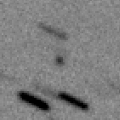
|
Now it is 17.5 mag (Nov. 27, Toshihiko Ikemura, Hirohisa Sato). It is observable at 17 mag from November to March. It is observable in good condition in the Northern Hemisphere, but it locates low in the Southern Hemisphere.
Date(TT) R.A. (2000) Decl. Delta r Elong. m1 Best Time(A, h)
Dec. 4 5 56.89 24 4.5 1.657 2.614 162 17.3 1:07 ( 0, 79)
Dec. 11 5 51.57 24 54.4 1.621 2.597 170 17.2 0:34 ( 0, 80)
|

|
It brightened up to 11.6 mag in winter (Feb. 18, Thomas Lehmann). Now it is fading. It has already faded down to 16.6 mag (Nov. 23, Thomas Lehmann). In the Southern Hemisphere, it stays observable in good condition after this. In the Northern Hemisphere, it will never be observable after this.
Date(TT) R.A. (2000) Decl. Delta r Elong. m1 Best Time(A, h)
Dec. 4 1 22.70 -63 28.6 4.504 4.543 86 17.2 20:28 ( 0, -8)
Dec. 11 1 15.39 -61 42.3 4.619 4.606 83 17.3 19:54 ( 0, -6)
|

|
Now it is 18.7 mag (Oct. 14, Catalina Sky Survey). In the Northern Hemisphere, it stays observable at 17 mag in good condition from November to December. It locates low in the Southern Hemisphere.
Date(TT) R.A. (2000) Decl. Delta r Elong. m1 Best Time(A, h)
Dec. 4 2 36.91 34 26.1 1.258 2.169 150 17.2 21:42 ( 0, 89)
Dec. 11 2 20.74 32 11.0 1.275 2.134 141 17.4 20:59 ( 0, 87)
|
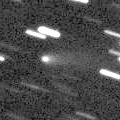
|
It brightened up to 15.2 mag in summer (Aug. 25, Ken-ichi Kadota). Now it is fading. It has already faded down to 17.5 mag (Nov. 28, Toshihiko Ikemura, Hirohisa Sato). It will be fainter than 18 mag in December. In the Northern Hemisphere, it stays observable in good condition for a long time. It locates extremely low in the Southern Hemisphere.
Date(TT) R.A. (2000) Decl. Delta r Elong. m1 Best Time(A, h)
Dec. 4 9 20.04 42 20.3 1.199 1.889 119 17.3 4:29 (180, 83)
Dec. 11 9 23.25 44 3.8 1.189 1.930 124 17.5 4:05 (180, 81)
|

|
Now it is 17.3 mag (Dec. 4, Toshihiko Ikemura, Hirohisa Sato). In the Northern Hemisphere, it stays observable for a long time while it is getting fainter slowly. In the Southern Hemisphere, it will never be observable again.
Date(TT) R.A. (2000) Decl. Delta r Elong. m1 Best Time(A, h)
Dec. 4 14 39.23 40 44.9 7.563 7.268 69 17.4 5:22 (243, 38)
Dec. 11 14 42.52 40 46.8 7.551 7.316 72 17.4 5:27 (244, 44)
|
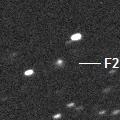
|
Now it is 17.8 mag (Aug. 4, ATLAS-HKO, Haleakala). It stays observable at 17-18 mag for a long time until 2024.
Date(TT) R.A. (2000) Decl. Delta r Elong. m1 Best Time(A, h)
Dec. 4 14 35.64 -5 53.5 9.709 8.912 34 17.4 5:22 (289, 16)
Dec. 11 14 36.80 -5 49.8 9.626 8.907 41 17.4 5:27 (295, 22)
|
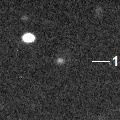
|
Now it is 16.9 mag (Dec. 1, Toshihiko Ikemura, Hirohisa Sato). It will brighten up to 15 mag in 2022 winter. In 2021, it stays observable in good condition while the comet will be brightening gradually.
Date(TT) R.A. (2000) Decl. Delta r Elong. m1 Best Time(A, h)
Dec. 4 22 40.32 -16 8.2 2.797 2.864 83 17.5 18:18 ( 9, 39)
Dec. 11 22 46.48 -15 20.4 2.868 2.840 78 17.4 18:19 ( 16, 38)
|
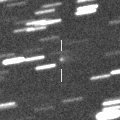
|
Now it is 17.1 mag (Nov. 28, Toshihiko Ikemura, Hirohisa Sato). In the Northern Hemisphere, it stays observable at 17 mag in good condition until winter. In the Southern Hemisphere, it stays locating extremely low for a while.
Date(TT) R.A. (2000) Decl. Delta r Elong. m1 Best Time(A, h)
Dec. 4 9 19.98 22 41.2 1.670 2.283 116 17.5 4:29 ( 0, 78)
Dec. 11 9 19.46 21 48.5 1.628 2.317 123 17.5 4:01 ( 0, 77)
|
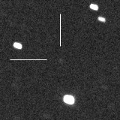
|
Now it is 17.8 mag (Nov. 25, ATLAS-HKO, Haleakala). It will brighten up to 11.5 mag in 2022 winter. It stays observable while the comet will be brightening slowly.
Date(TT) R.A. (2000) Decl. Delta r Elong. m1 Best Time(A, h)
Dec. 4 3 16.55 13 36.5 2.474 3.409 158 17.6 22:22 ( 0, 69)
Dec. 11 3 11.06 13 19.4 2.485 3.373 149 17.5 21:50 ( 0, 68)
|
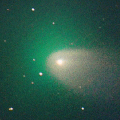
|
It brightened up to 9.7 mag in June (June 4, Michael Jager). Now it is fading. It has already faded down to 17.7 mag (Dec. 1, Toshihiko Ikemura, Hirohisa Sato). In the Southern Hemisphere, it stays observable in excellent condition for a long time. In the Northern Hemisphere, it becomes extremely low after this.
Date(TT) R.A. (2000) Decl. Delta r Elong. m1 Best Time(A, h)
Dec. 4 23 45.14 -28 59.8 2.145 2.397 92 17.7 18:52 ( 0, 26)
Dec. 11 23 52.07 -27 3.4 2.275 2.449 88 18.0 18:32 ( 0, 28)
|
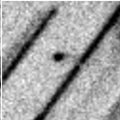
|
Now it is 17.6 mag (Nov. 27, Toshihiko Ikemura, Hirohisa Sato). It is observable at 17-18 mag in good condition from November to December.
Date(TT) R.A. (2000) Decl. Delta r Elong. m1 Best Time(A, h)
Dec. 4 4 57.73 11 3.7 0.948 1.924 168 17.7 0:09 ( 0, 66)
Dec. 11 4 33.70 16 29.6 0.961 1.937 168 17.8 23:10 ( 0, 72)
|
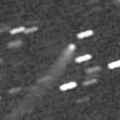
|
Now it is 17.5 mag (Nov. 13, D. Buczynski). Fading slowly. In the Northern Hemisphere, it stays observable in good condition for a long time. It is not observable after this in the Southern Hemisphere.
Date(TT) R.A. (2000) Decl. Delta r Elong. m1 Best Time(A, h)
Dec. 4 16 40.63 48 0.7 6.411 6.147 70 17.7 5:22 (225, 21)
Dec. 11 16 44.52 48 22.3 6.423 6.183 71 17.8 5:27 (227, 26)
|
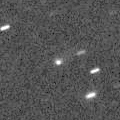
|
Now it is 17.4 mag (Nov. 23, F. Kugel, J. Nicolas, J.-G. Bosch). It will be observable at 17 mag in good condition in spring.
Date(TT) R.A. (2000) Decl. Delta r Elong. m1 Best Time(A, h)
Dec. 4 13 11.41 -6 12.3 5.260 4.732 52 17.8 5:22 (305, 31)
Dec. 11 13 16.63 -6 45.8 5.166 4.729 58 17.8 5:27 (312, 35)
|
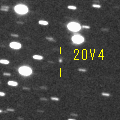
|
Now it is 17.7 mag (Dec. 2, Toshihiko Ikemura, Hirohisa Sato). It is observable at 18 mag in good condition in winter.
Date(TT) R.A. (2000) Decl. Delta r Elong. m1 Best Time(A, h)
Dec. 4 8 7.82 3 29.4 4.549 5.197 126 17.9 3:17 ( 0, 58)
Dec. 11 8 6.55 3 16.2 4.476 5.202 133 17.9 2:49 ( 0, 58)
|
|
![]()
 422P/2021 L1 ( Christensen )
422P/2021 L1 ( Christensen ) C/2019 O3 ( Palomar )
C/2019 O3 ( Palomar ) 28P/Neujmin 1
28P/Neujmin 1 15P/Finlay
15P/Finlay C/2020 S4 ( PanSTARRS )
C/2020 S4 ( PanSTARRS ) 230P/LINEAR
230P/LINEAR C/2020 U4 ( PanSTARRS )
C/2020 U4 ( PanSTARRS ) 274P/Tombaugh-Tenagra
274P/Tombaugh-Tenagra C/2019 N1 ( ATLAS )
C/2019 N1 ( ATLAS ) (3200) Phaethon
(3200) Phaethon 106P/Schuster
106P/Schuster C/2018 N2 ( ASASSN )
C/2018 N2 ( ASASSN ) C/2020 F2 ( ATLAS )
C/2020 F2 ( ATLAS ) 119P/Parker-Hartley
119P/Parker-Hartley 241P/LINEAR
241P/LINEAR 81P/Wild 2
81P/Wild 2 7P/Pons-Winnecke
7P/Pons-Winnecke P/2021 U3 ( Attard-Maury )
P/2021 U3 ( Attard-Maury ) C/2019 K7 ( Smith )
C/2019 K7 ( Smith ) 99P/Kowal 1
99P/Kowal 1 P/2020 V4 ( Rankin )
P/2020 V4 ( Rankin )![]()







































































